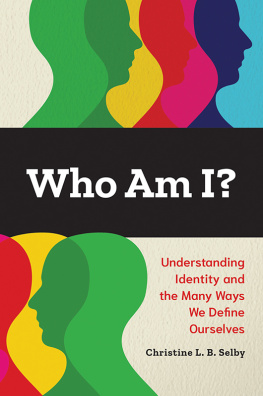ROUTLEDGE LIBRARY EDITIONS:
URBAN STUDIES
Volume 8
IDENTITY AND POVERTY
IDENTITY AND POVERTY
Defining a Sense of Self Among
Urban Adolescents
LAURA DEHAAN AND SHELLEY MACDERMID
First published in 1996 by Garland Publishing, Inc.
This edition first published in 2018
by Routledge
2 Park Square, Milton Park, Abingdon, Oxon OX14 4RN
and by Routledge
711 Third Avenue, New York, NY 10017
Routledge is an imprint of the Taylor & Francis Group, an informa business
1996 Laura DeHaan and Shelley MacDermid
All rights reserved. No part of this book may be reprinted or reproduced or utilised in any form or by any electronic, mechanical, or other means, now known or hereafter invented, including photocopying and recording, or in any information storage or retrieval system, without permission in writing from the publishers.
Trademark notice: Product or corporate names may be trademarks or registered trademarks, and are used only for identification and explanation without intent to infringe.
British Library Cataloguing in Publication Data
A catalogue record for this book is available from the British Library
ISBN: 978-1-138-89482-2 (Set)
ISBN: 978-1-315-09987-3 (Set) (ebk)
ISBN: 978-1-138-89648-2 (Volume 8) (hbk)
ISBN: 978-1-315-17908-7 (Volume 8) (ebk)
Publishers Note
The publisher has gone to great lengths to ensure the quality of this reprint but points out that some imperfections in the original copies may be apparent.
Disclaimer
The publisher has made every effort to trace copyright holders and would welcome correspondence from those they have been unable to trace.
IDENTITY
AND
POVERTY
D EFINING A S ENSE OF S ELF
A MONG U RBAN A DOLESCENTS
____________________
LAURA D E HAAN
SHELLEY M AC DERMID
GARLAND PUBLISHING, I NC .
N EW Y ORK & L ONDON /1996
Contents
- Chapter I
Identity And Poverty - Chapter II
Context Of Urban Poverty - Chapter III
Identity Development - Chapter IV
Outcomes For Adolescents In Urban Poverty - Chapter V
Method Of Study - Chapter VI
Results Of Study - Chapter VII
Discussion
Copyright 1996 Laura DeHaan and Shelley MacDermid All rights reserved
Library of Congress Cataloging-in-Publication Data
DeHaan, Laura, 1964
Identity and poverty : defining a sense of self among urban adolescents / Laura DeHaan & Shelley MacDermid.
p. cm. (Children of poverty)
Includes bibliographical references and index.
ISBN 0-8153-2622-X (alk. paper)
1. Urban poorUnited StatesPsychology. 2. Poor teenagersUnited StatesPsychology. 3. Identity (Psychology) in adolescenseSocial aspectsUnited States. I. MacDermid, Shelley, 1959 . II. Title. III. Series.
HV4045.D45 1996
305.235dc20 96-36694
Printed on acid-free, 250-year-life paper
Manufactured in the United States of America
It is impossible to live in current society and not hear about the strong challenges that youth face in this country. American adolescents are facing unprecedented challenges, such as gang violence, AIDs and substance use, and are being asked to make difficult choices concerning these issues at younger and younger ages. Perhaps one of the most potentially dangerous environments for todays teens is within inner cities, where crime and poverty are serious problems.
One of the things that has always been striking to us is the fact that even though todays adolescents are faced with such difficult choices, most adolescents are able to handle the transition from childhood to adulthood very well. Even adolescents growing up with very adverse circumstances are usually able to grow into confident and competent adults. One of the goals of this project was to examine the kinds of factors help adolescents succeed, particularly those living in a risky environment, such as an inner city.
This book examines an important developmental transition: the formation of identity, as well as the influence that having a well developed identity may have, on a sample of 102 eighth graders living in urban Chicago. We found that although growing up in poverty does hamper identity development, creating a strong sense of self is an important protective factor for these adolescents who are living in an environment characterized by high stress. Creating a strong sense of identity as associated with lower levels of risk, particularly for behavioral outcomes. We also find that measuring identity development within specific domains makes an important contribution to our knowledge of how identity relates to outcomes for early adolescents.
This project was made possible by a grant from the Purdue Research Foundation at Purdue University and many people played a crucial role in the completion of this project. The first author is especially indebted to Shelley MacDermid for giving constant support to this project and challenging me to grow as a scholar. I also appreciate her willingness to allow me to pursue a whole new area of study that was somewhat unfamiliar to all of us. Thanks also go to Judith Myers-Walls, David Fasenfest, and Gail Melson who served on my dissertation commitee, for competent help and expertise. We are also grateful for Ellen Smith, Tom Ritter, and Todd and Julie Weiland for competent help in data gathering, and to Lauras husband Mike, for providing much computer support all throughout this project. Greatest thanks are of course due to the school systems, parents, and teens who allowed us to complete this project and for sharing their lives with us.
Laura DeHaan & Shelley MacDermid
Identity and Poverty
I
Identity and Poverty
Over fourteen million children and adolescents in the United States, about 22% of all American children and adolescents, live in poverty (Dinitto, 1995). An even higher percentage of urban children and adolescents live with economic hardship. Wilson (1987) reports that 58% of all urban white families and 75% of all urban black families earn under 11,000 dollars a year. This compares to national rates of 13% for white families and 18% for black families.
As the number of individuals living in urban poverty increased (59% from the years 1969 to 1982), concern about people in these environments, particularly youth, also increased (Wilson, 1987). Considerable efforts have been made to ascertain the effects of economic hardship on physical and mental health (Bolger, Patterson, Thompson and Kuperschmidt, 1995; Huston, McLoyd and Coll, 1994).
Thompson (1992) argues that poverty alone does not cause adverse developmental outcomes. However, the consequences of experiencing the conditions associated with growing up in poverty are not in doubt (p. 7). He cites poor nutrition, lack of access to medical care, unsafe living conditions, exposure to drugs, and high crime rates as some of the problems associated with urban poverty. Garmezy (1992) also notes many risk factors associated with children living in urban poverty, risks often beginning in infancy. Low birth weight and higher rates of infant mortality are among the common problems. In a qualitative study of children in five cultures that were deemed war zones because of the intense violence and uncertainty of life for children, Garbarino, Kostelny, and Dubrow (1991) described inner-city Chicago as more dangerous and stressful for children than places such as Cambodia, Nicaragua, or Palestine!









